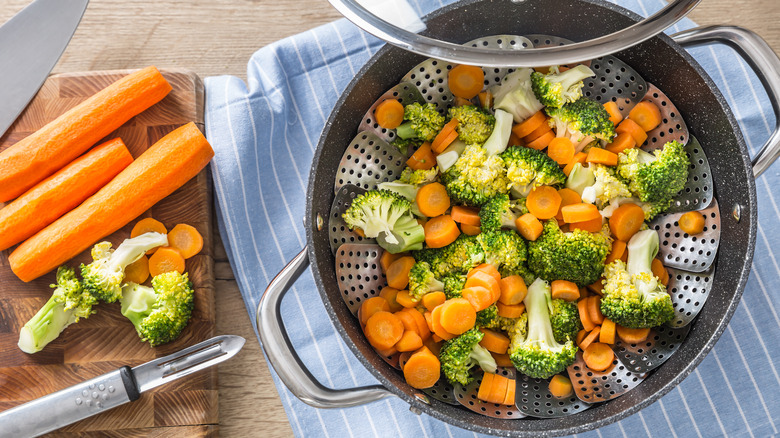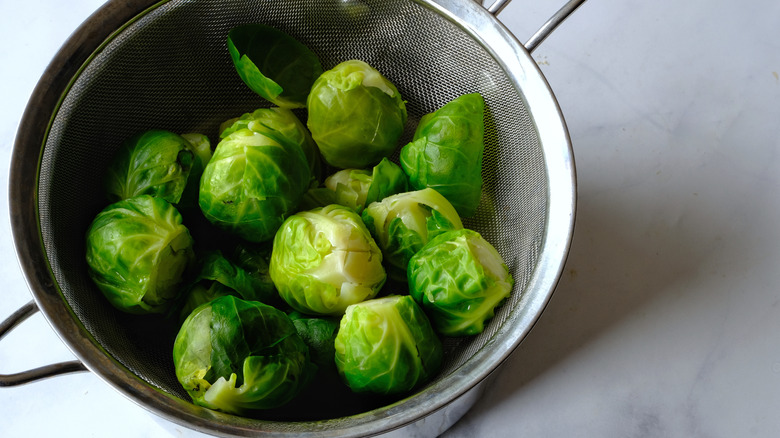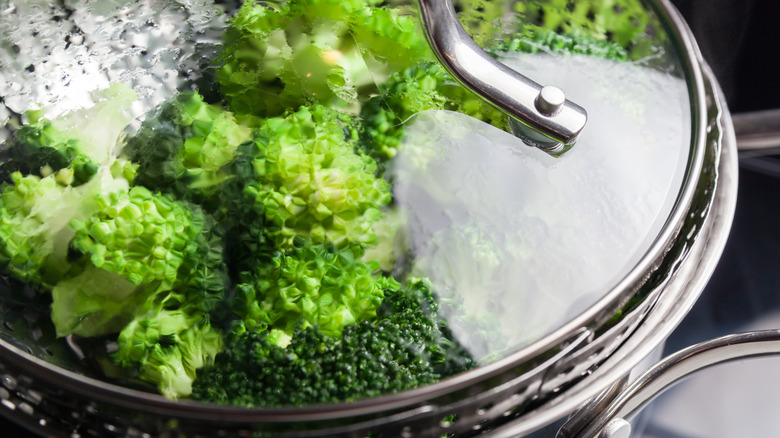Why Steamed Vegetables Don't Deserve Their Bad Reputation
If the thought of steaming vegetables conjures up an image of a side of soggy gray-green mush on your plate, keep reading. Steaming veggies gets a bad rap, but not for any good reason — it's arguably one of the best methods of preparation if you're looking to maximize the nutrition, flavor, color, and texture of the vegetable. Steaming maintains the integrity of the vegetable — and it's time we start showing our broccoli some respect.
The only downside to steaming, perhaps, is waiting for the water to boil. But as long as you don't watch the pot, it shouldn't take any longer than a good old oven preheat.
There's a fine line between a crisp, crunchy bite of steamed broccoli and a dull, mushy army-green Brussels sprout. As with most things culinary, it comes down to technique, but it isn't hard at all to do a proper steam. It couldn't be easier, in fact. What are the benefits of steaming your vegetables, and what is the best way to go about it?
Why you should consider steaming your vegetables
Let's start with the inconspicuous benefit of steaming vegetables — nutrition. When it comes to cooking methods and nutrient loss, steaming can't be beaten. A study published in the Journal of Zhejiang University in 2009 found that steaming broccoli retained the most nutrients compared to other methods of preparation. Additionally, there's no need to use oil or cooking fat when you steam, making it a lighter option than roasting. Not to mention, steaming begins the food's breakdown process, making it easier on your digestive system. If raw veggies upset your stomach, steaming will give you the same bang for your buck nutrition-wise while giving your tummy a break (via Runner's World).
Up next is taste and appearance. Steaming retains the vegetable's inherent flavor, maintains its shape, and enhances the veggie's texture (via Cooked Best). If you've ever enjoyed a properly steamed Brussels sprout, you're aware of how its mustard undertones are amplified compared to the crispy nuttiness that results from roasting the little green globes. Because the vegetables are heated only briefly while steaming, their bright colors are preserved and even enriched when you get the timing just right.
Last but not least, and definitely worthy of a mention, steaming is quick and requires minimal equipment and cleanup. What's the best way to do it?
Best practices for steaming vegetables
A few things to keep in mind when opting for vegetable steaming are the type of veggie, the time available, and the vessel you're using. Sturdier vegetables are great for steaming. Think broccoli, cauliflower, carrots, green beans, asparagus, new potatoes, zucchini, and artichokes, per The Seattle Times. Leafy greens, such as spinach, kale, and bok choy, are also great for steaming and take no time at all. Large, denser chunks of vegetables, like potatoes and squash, are a bit more difficult to cook with the method, so be sure to cut all pieces into a small, uniform size so they cook through.
The easiest tool to steam vegetables is a steamer basket placed in a pot with a couple of inches of water at the bottom. Keep the vegetables elevated in that basket or a colander — don't let them touch the water, per A Couple Cooks, to avoid sogginess.
Once the water is at a rolling boil and you've dropped your veggies into the basket and covered them, you'll want to start checking repeatedly to see when they become fork-tender. Once they do, remove the vegetables from the basket. Vegetables will continue to cook once you remove them from the heat, so there are a few things you can do to stop the process. You can shock them with a bath in a bowl of ice water, or an easier approach that One Green Planet recommends is to just run them under cold water in a colander.


